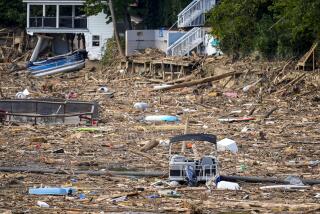Hurricane Milton slams into Florida, bringing violent winds, flooding and fatalities

- Loss of life was reported at a retirement home in St. Lucie County.
- One south Florida resident watched a tornado before realizing it was headed toward his home. It “sucked the whole roof off.”
OCALA, Fla. — Hurricane Milton slammed into Florida’s west coast on Wednesday, dumping rain, spawning deadly tornadoes, causing widespread flooding and cutting power to millions.
After making landfall near Sarasota as a Category 3 hurricane around 8:30 p.m. EDT, the storm tore a trail of destruction across the state — ripping part of the roof off the Tampa Bay Rays’ stadium, causing a crane to collapse onto a building in downtown St. Petersburg and resulting in multiple fatalities at a retirement home in St. Lucie County.
The eye of the hurricane hovered over Sarasota County along the west coast of Florida around 9 p.m., producing 120-mph winds, according to the National Hurricane Center. An hour later, the storm was downgraded to Category 2 and moved into the Tampa Bay area, where a flash flood emergency was declared, the center said.
By 1 a.m., the storm had reached the Orlando metro area and was downgraded to Category 1, according to the Weather Channel.
At that time, more than 2.4 million households statewide were without power, according to PowerOutage.us.
Forecasters predicted the storm would reach the Atlantic by sunrise Thursday.
In St. Lucie County, on the state’s eastern coast, Sheriff Keith Pearson told local media that there were multiple fatalities after a hurricane hit the Spanish Lakes Country Club, a senior community. A search and rescue mission was ongoing Wednesday night.
There were a record number of tornado warnings from the leading edge of the hurricane, the Weather Channel reported. The Storm Prediction Center counted at least 21 tornadoes reported statewide, the site said, with widespread damage along the state’s Atlantic Coast.
There were reports Wednesday evening of major damage to structures along Florida’s west coast, including in Sarasota and Naples. By about 10 p.m., the Albert Whitted Airport in St. Petersburg had received more than 16 inches of rain.
Also in St. Petersburg, the Tampa Bay Rays’ Tropicana Field was missing part of its roof, and a crane collapsed onto the McNulty Building downtown, which houses the offices of the Tampa Bay Times. The city had to shut off potable water to residents at midnight after a water main broke, officials said.
Videos and photos on social media showed heavy rain and power lines swinging as a stormwater pushed into homes. One video showed several feet of water slapping against the stairway of a home in Nokomis. At Venice Bay Park, a mobile home park in Venice, several homes were partially submerged.
As the hurricane made landfall Wednesday evening, Gov. Ron DeSantis said on social media platform X, “Now is the time to shelter in place. First responders are staged and ready to go, as soon as weather conditions allow. Search and rescue efforts will be well underway to save lives before dawn, and they will continue for as long as it takes.”
Earlier in the day, President Biden said Milton “could be the worst storm to hit Florida in over a century.”
“God willing, it won’t be,” the president said. “My priority is to increase the size and presence of our [federal personnel] ... as we prepare for another catastrophic storm about to make landfall.”
California Gov. Gavin Newsom said Wednesday evening in a post on X that California had deployed 354 emergency personnel to Florida to help with hurricane response. The governor wrote that, when disaster hits, Americans stand “united to help one another.”
The storm comes less than two weeks after Hurricane Helene devastated communities across the Southeast.
“This is going to be a serious storm, one that could forever change communities that are still recovering from Helene,” Federal Emergency Management Agency Administrator Deanne Criswell said at a briefing earlier Wednesday.
But despite facing back-to-back large-scale disasters, officials said FEMA was prepared for Hurricane Milton, having positioned food and water resources for millions, as well as bringing in additional personnel, including extra search and rescue teams, power assessment teams and ambulances to assist with evacuating medical facilities.
Criswell didn’t minimize the immense challenge facing the agency, which is responding to the most federal disasters in any one year of her tenure.
“As we continue to see the impacts of climate change cause more severe weather events across the U.S., we are going to see more communities impacted, and we are going to see them continue to need assistance,” Criswell said. She said that “storm after storm” had been more intense, with more water, more wind and more destruction.
Scientists for years have found that human-caused changes in climate, particularly warming ocean temperatures, supercharge tropical storms in the Atlantic, fueling more rain and stronger winds.
Already, a team of international scientists has determined that climate change made it up to 500 times more likely that Hurricane Helene would encounter such high surface temperatures in the Gulf of Mexico, driving the storm’s rapid intensification and unprecedented moisture.
The storm’s rainfall was also about 10% heavier because of climate change, according to the new analysis from the World Weather Attribution, a group of scientists from the United States, the United Kingdom, Sweden and the Netherlands who calculate the role of climate change in extreme weather events using weather observations and computer modeling.
The storm surge between Anna Maria Island and Boca Grande, including Sarasota, was expected to reach 9 to 13 feet, the National Weather Service forecast.
Nearly 6 million people had been told to evacuate, one of the biggest such orders in Florida history.
Late Wednesday, the Weather Channel reported from the second floor of a parking garage at Port Charlotte, south of Sarasota, where the first floor was totally underwater due to a storm surge.
In Fort Myers, a homeowner saw the tornado that ripped his roof off in south Florida early Wednesday afternoon, he told an AccuWeather reporter. Robert Haight said he saw the tornado and told his wife and child to come look at it, before realizing it was getting closer.
“Didn’t even make it [to the hallway] in time,” Haight said. “I heard a piece of glass crack and [it] sucked the whole roof off.”
Tampa Mayor Jane Castor said earlier Wednesday that, with ample warning, the city was hopeful it could avoid deaths from the storm surge, which was forecast to reach 6 to 9 feet in Tampa Bay.
The northbound lanes of Interstate 75, which runs west from Fort Lauderdale to Naples before heading north through Tampa and into Georgia, were gridlocked for much of Monday and into Tuesday morning. As of Wednesday, more than 20% of gas stations in Florida were reported to be out of fuel, including almost 60% of gas stations in Tampa and St. Petersburg, according to GasBuddy.

Hurricane Helene entered Florida’s Big Bend region late on Sept. 26 as a Category 4 storm, eventually claiming more than 230 lives as it left a trail of devastation from Florida to Tennessee and the Carolinas.
Criswell said teams remained on the ground in North Carolina and other states most affected by Helene, noting that $60 million has already been distributed to more than 51,000 households in FEMA’s individual assistance program. That program provides cash to disaster victims to help pay for emergency supplies, including food, water, baby formula and medication.
“This is incredible, meaningful progress,” she said.
But with a massive amount of work still to be done to recover from Helene and now megastorm Milton, Criswell said, funding could soon be a major roadblock for the agency, which is still addressing more than 100 federally designated disasters across the country.
“I have the funding and sufficient resources to support the ongoing responses to Hurricane Helene as well as Hurricane Milton, but I’m going to have to evaluate how quickly we’re burning the remaining dollars,” Criswell said. The agency’s Disaster Relief Fund had $11 billion as of Tuesday, she said, but those funds are used for immediate disaster response, as well as recovery reimbursements.
FEMA has already requested an additional $9 billion from Congress, Criswell said, but expects that amount will need to be increased.
Just as climate change has supercharged hurricanes, warming global temperatures probably have played a role in what Criswell said had been a year of increased severe weather events. FEMA is still helping states recover from an unusually busy tornado season, several massive wildfires and historic flooding, she said.
Some residents of Florida’s Gulf Coast resisted the calls to evacuate. For example, Michael Bobbitt of Cedar Key, which is about 130 miles northwest of Sarasota, told ABC News that he risked his life to help his neighbors during Helene, which inundated the town with about 12 feet of storm surge. He planned to do the same for Milton, he said.
“There’s something baked into the psyche of living on an island like this. We’re hardscrabble folks,” Bobbitt said. “There’s something in the Florida mentality about not letting the weather get the best of you.”
Despite being under a mandatory evacuation order, Bobbitt said he was staying to help the people who weren’t willing to leave. He has a boat, a team and tactical tools, he said, to assist his neighbors.
Piles of debris from Helene, which made landfall two weeks ago, are “stacked multiple stories high all over the island” and may turn into missiles when the wind picks up, Bobbitt said.
“The government’s slow to come help,” he said, “so I think a lot of people are slow to do what they tell us to do.”
McDonald reported from Ocala; Toohey, Vives and Harter from Los Angeles.
More to Read
Sign up for Essential California
The most important California stories and recommendations in your inbox every morning.
You may occasionally receive promotional content from the Los Angeles Times.














